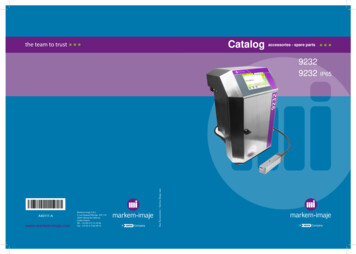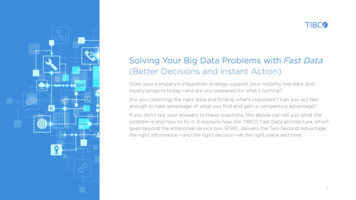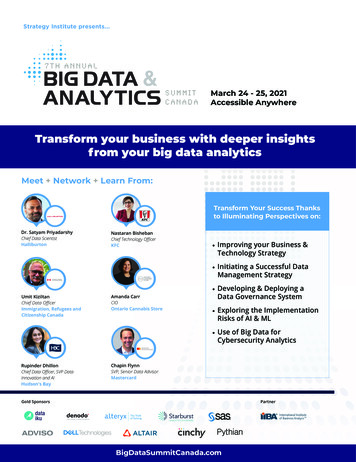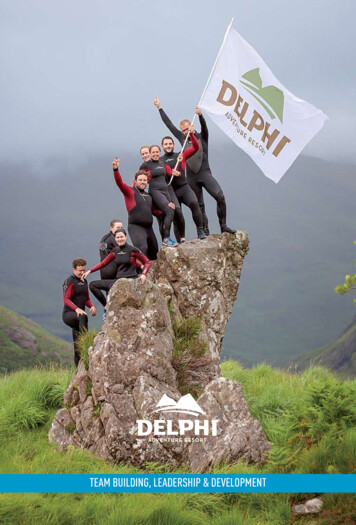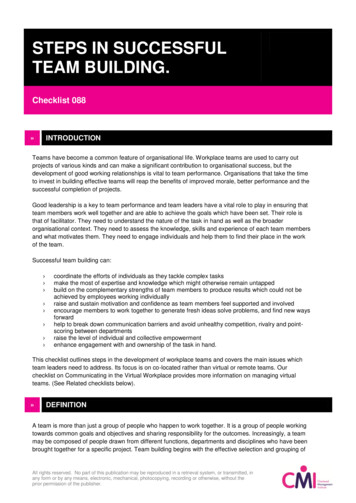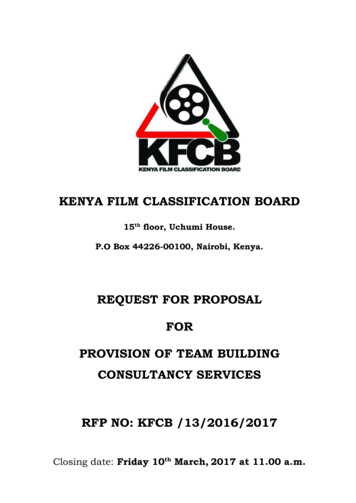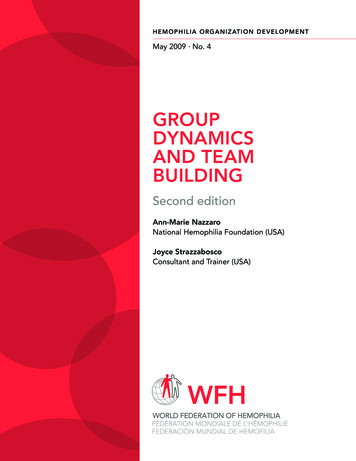
Transcription
DesignMindBuilding Your Big Data TeamWith all the buzz around Big Data, many companies have decided they need some sort of Big Data initiativein place to stay current with modern data management requirements. Platforms like Hadoop promise scalabledata storage and processing at lower cost than traditional data platforms, but the newer technology requiresnew skill sets to plan, build and run a Big Data program. Companies not only have to determine the right BigData technology strategy, they need to determine the right staffing strategy to be successful.What comprises a great Big Data team? Luckily the answer isn’t that far fromwhat many companies already have in house managing their data warehouse ordata services functions. The core skill sets and experience in the areas of systemadministration, database administration, database application architecture /engineering and data warehousing are all transferable. What usually makes someoneable to successfully make the leap from, say, Oracle DBA to Hadoop administratoris their motivation to learn and more curiosity about what’s happening under thecovers when data are loaded or a query is run. Here are the key roles your (Hadoop)Big Data team needs to fill to be complete.The first three roles are about building and operatinga working Hadoop platform:1. Data Center and OS AdministratorThis person is the one who stands up machines, virtual or otherwise, and presentsAbout DesignMindDesignMind uses leadingedge technologies, includingSQL Server, SharePoint,.NET, Tableau, Hadoop, andPlatfora to develop big datasolutions. Headquarteredin San Francisco, we helpbusinesses leverage theirdata to gain competitiveadvantage.a fully functional system with working disks, networking, etc. They’re usually alsoresponsible for all the typical data center services (LDAP/AD, DNS, etc.) and knowhow to leverage vendor-specific tools (e.g., Kickstart and Cobbler, or vSphere) toprovision large numbers of machines quickly. This role is becoming increasinglysophisticated and/or outsourced with the move to infrastructure as a serviceapproaches to provisioning, with the DC role installing hardware and maintainingthe provisioning system, and developers interfacing with that system ratherthan humans.DesignMind A white paper by Mark Kidwell, Principal Big Data Consultant, DesignMind September 2014Copyright 2014 DesignMind. All rights reserved.1
DesignMindWhile this role usually isn’t (shouldn’t be) part of the core Big Data team, it’smentioned here because it’s absolutely critical to building a Big Data platform.Anyone architecting a new platform needs to partner closely with the data centerteam to specify requirements and validate the build out.BACKGROUND/PREVIOUS ROLE: This role typically already exists, either in theorganization or via a cloud hosted solution’s web site.TRAINING/RETOOLING: If you still run your own data center operations, definitely“ Anyone architecting anew platform needsto partner closelywith the data centerteam to specifyrequirements andvalidate the build out.”look at large scale virtualization and server management technologies that supportself-service provisioning if you haven’t already.2. Hadoop AdministratorThis person is responsible for set up, configuration, and ongoing operation ofthe software comprising your Hadoop stack. This person wears a lot of hats, andtypically has a DevOps background where they’re comfortable writing code and/orconfiguration with tools like Ansible to manage their Hadoop infrastructure. Skillsin Linux and MySQL / PostgreSQL administration, security, high availability, disasterrecovery and maintaining software across a cluster of machines is an absolute must.For the above reasons, many traditional DBAs aren’t a good fit for this type of roleeven with training (but see below).BACKGROUND/PREVIOUS ROLE: Linux compute / web cluster admin, possibly a DBAor storage admin.TRAINING/RETOOLING: Hadoop admin class from Cloudera, Ansible training fromansible.com, plus lots of lab time to play with the tools.3. HDFS/Hive/Impala/HBase/MapReduce/Spark AdminLarger Big Data environments require specialization, as it’s unusual to find anexpert on all the different components - tuning Hive or Impala to perform at scaleis very different from tuning HBase, and different from the skills required to have aworking high availability implementation of Hive or HttpFS using HAProxy. SecuringHadoop properly can also require dedicated knowledge for each component andvendor, as Cloudera’s Sentry (Hive / Impala / Search security) is a different animalthan Hortonworks’s Knox perimeter security. Some DBAs can successfully make thetransition to this area if they understand the function of each component.2
DesignMindBACKGROUND/PREVIOUS ROLE: Linux cluster admin, MySQL / Postgres / Oracle DBA.See Gwen Shapira’s excellent blog on Cloudera’s site called “the Hadoop FAQ forOracle DBAs.”TRAINING/RETOOLING: Hadoop admin and HBase classes from Cloudera, plus lots oflab time to play with all the various technologies.The next four roles are concerned with getting data intoHadoop, doing something with it, and getting it back out:4. ETL / Data Integration DeveloperThis role is similar to most data warehouse environments - get data from sourcesystems of record (other databases, flat files, etc), transforming it into somethinguseful and loading into a target system for querying by apps or users. Thedifference is the tool chain and interfaces the Hadoop platform provides, and thefact that Hadoop workloads are larger. Hadoop provides basic tools like Sqoopand Hive that any decent ETL developer that can write bash scripts and SQL canuse, but understanding that best practice is really ELT (pushing the heavy lifting oftransformation into Hadoop) and knowing which file formats to use for optimal Hiveand Impala query performance are both the types of things that have to be learned.3
DesignMindA dangerous anti-pattern is to use generic DI tools / developers to load your BigData platform. They usually don’t do a good job producing high performance datawarehouses with non-Hadoop DBs, and they won’t do a good job here.BACKGROUND/PREVIOUS ROLE: Data warehouse ETL developer with experience onhigh-end platforms like Netezza or Teradata.TRAINING/RETOOLING: Cloudera Data Analyst class covering Hive, Pig and Impala,“ Focus on delivering ausable data productquickly, rather thanmodeling every lastdata source acrossthe enterprise.”and possibly the Developer class.5. Data ArchitectThis role is typically responsible for data modeling, metadata, and data stewardshipfunctions, and is important to keep your Big Data platform from devolving into a bigmess of files and haphazardly managed tables. In a sense they own the data hostedon the platform, often have the most experience with the business domain andunderstand the data’s meaning (and how to query it) more than anyone else exceptpossibly the business analyst. The difference between a traditional warehouse dataarchitect and this role is Hadoop’s typical use in storing and processing unstructureddata typically outside this role’s domain, such as access logs and data from amessage bus.For less complex environments, this role is only a part-time job and is typicallyshared with the lead platform architect or business analyst. An important caveatfor data architects and governance functions in general—assuming your Big Dataplatform is meant to be used for query and application workloads (vs. simple dataarchival), it’s important to focus on delivering a usable data product quickly, ratherthan modeling every last data source across the enterprise and exactly how it willlook as a finished product in Hadoop or Cassandra.BACKGROUND/PREVIOUS ROLE: Data warehouse data architect.TRAINING/RETOOLING: Cloudera Data Analyst class covering Hive, Pig and Impala.4
DesignMind6. Big Data Engineer / ArchitectThis developer is the one writing more complex data-driven applications thatdepend on core Hadoop applications like HBase, Spark or SolrCloud. These areserious software engineers developing products from their data for use caseslike large scale web sites, search and real-time data processing that need theperformance and scalability that a Big Data platform provides. They’re usually wellversed in the Java software development process and Hadoop toolchain, and aretypically driving the requirements around what services the platform provides andhow it performs.For the Big Data architect role, all of the above applies, but this person is alsoresponsible for specifying the entire solution that everyone else in the team is workingto implement and run. They also have a greater understanding of and appreciation forproblems with large data sets and distributed computing, and usually some systemarchitecture skills to guide the build out of the Big Data ecosystem.BACKGROUND/PREVIOUS ROLE: Database engineers would have been doing thesame type of high performance database-backed application development, butmay have been using Oracle or MySQL as a backend previously. Architects wouldhave been leading the way in product development that depended on distributedcomputing and web scale systems.TRAINING/RETOOLING: Cloudera’s Data Analyst, Developer, Building Big DataApplications, and Spark classes.5
DesignMind7. Data ScientistThis role crosses boundaries between analyst and engineer, bringing together skillsin math and statistics, machine learning, programming, and a wealth of experience/ expertise in the business domain. All these combined allow a data scientist tosearch for insights in vast quantities of data stored in a data warehouse or Big Dataplatform, and perform basic research that often leads to the next data product forengineers to build. The key difference between traditional data mining experts andmodern data scientists is the more extensive knowledge of tools and techniques fordealing with ever growing amounts of data. My colleague Andrew Eichenbaum haswritten a great article on hiring data scientists.BACKGROUND/PREVIOUS ROLE: Data mining, statistician, applied mathematics.“ The key differencebetween traditionaldata mining expertsand modern datascientists is the moreextensive knowledgeof tools and techniquesfor dealing with evergrowing amountsof data.”TRAINING/RETOOLING: Cloudera’s Intro to Data Science and Data Analyst classes.The final roles are the traditional business-facing roles fordata warehouse, BI and data services teams:8. Data AnalystThis role is largely what you’d expect - using typical database client tools as theinterface, they run queries against data warehouses, produce reports, and publishthe results. The skills required to do this are a command of SQL, including dialectsused by Hive and Impala, knowledge of data visualization, and understanding howto translate business questions into something a data warehouse can answer.BACKGROUND/PREVIOUS ROLE: Data Analysts can luckily continue to use a lot of thesame analytics tools and techniques they’re used to, and benefit from improvementsin both performance and functionality.TRAINING/RETOOLING: Cloudera’s Data Analyst class covering Hive, Pig and Impala.9. Business AnalystLike the data analyst, this role isn’t too different from what already exists in mostcompanies today. Gathering requirements from end users, describing use casesand specifying product behavior will never go away, and are even more importantwhen the variety of data grows along with volume. What’s most different is the toolsinvolved, their capabilities, and the general approach. The business analyst needs tobe sensitive to the difference in end-user tools with Hadoop, and determine trainingneeded for users.6
DesignMindBACKGROUND/PREVIOUS ROLE: Business / system analyst for previous dataproducts, like a data warehouse / BI solution, or traditional database-backed webapplication.TRAINING/RETOOLING: Possibly Cloudera’s Data Analyst class covering Hive, Pig andImpala, especially if this role will provide support to end users and analysts.What’s the Right Approach?All of the above roles mention Hadoop and target data warehousing use cases, butmany of the same guidelines apply if Apache Cassandra or similar NoSQL platform“ The time invested intraining and buildingout the team will payoff when it’s time toleverage your dataat scale with theproduction platform,improving the odds ofyour Big Data programbeing a success.”is being built out. And of course there are roles that are needed for any software orinformation management project – project managers, QA / QC, etc. For those rolesthe 1 day Cloudera Hadoop Essentials class might be the best intro.So with the above roles defined, what’s the right approach to building out a Big Datateam? A Big Data program needs a core group of at least one each of an architect,admin, engineer and analyst to be successful, and for a team that small there’s still alot of cross over between roles. If there’s an existing data services or data warehouseteam taking on the Big Data problem then it’s important to identify who will takeon those roles and train them, or identify gaps that have to be filled by new hires. Ofcourse the team needs to scale up as workload is added (users, apps and data), alsoaccounting for existing needs.Transforming into a Big Data capable organization is a challenging prospect, so it’salso a good idea to start with smaller POCs and use a lab environment to test thewaters. The time invested in training and building out the team will pay off whenit’s time to leverage your data at scale with the production platform, improving theodds of your Big Data program being a success.Mark Kidwell specializes in designing, building, and deploying custom end-to-endBig Data solutions and data warehouses.DesignMind 150 Spear Street, Suite 700, San Francisco, CA 94105 415-538-8484 designmind.comCopyright 2014 DesignMind. All rights reserved.7
TRAINING/RETOOLING: Cloudera Data Analyst class covering Hive, Pig and Impala, and possibly the Developer class. 5. Data Architect This role is typically responsible for data modeling, metadata, and data stewardship functions, and is important




